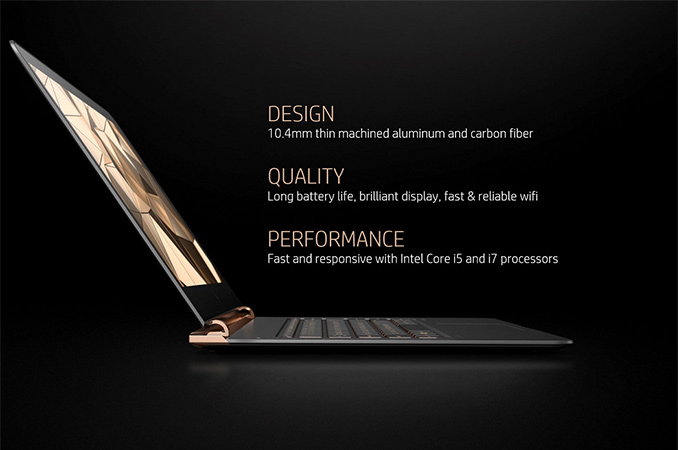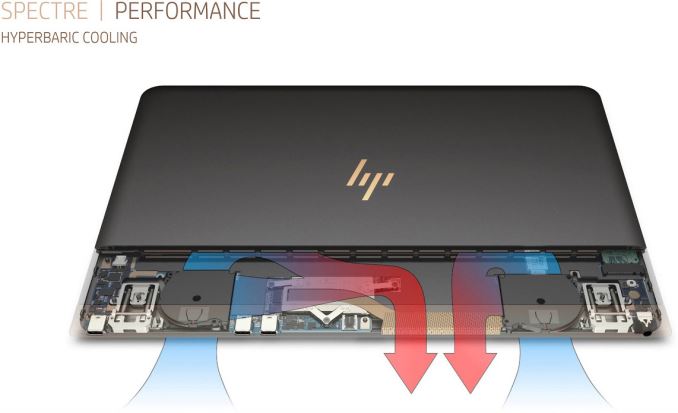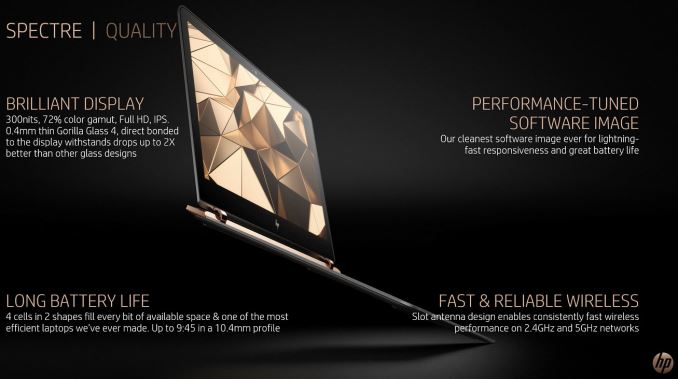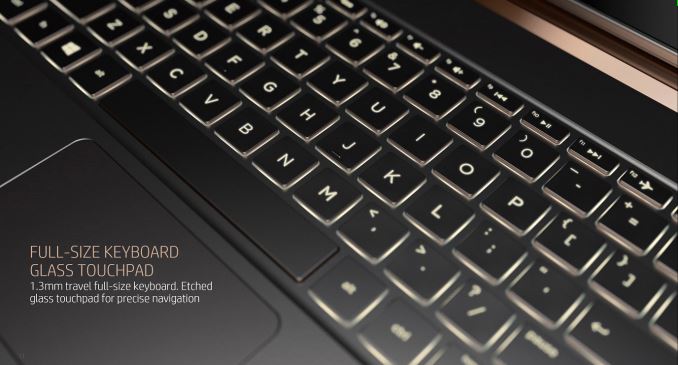HP Unveils Spectre: The World’s Thinnest Laptop
by Anton Shilov on April 5, 2016 11:59 AM EST
HP has announced its new Spectre laptop - the world’s thinnest 13.3” notebook. Despite its miniature size, the Spectre uses Intel’s Core i5/i7 microprocessor, a PCIe-based SSD, a full-size keyboard as well as an advanced audio system developed by Bang & Olufsen. To build its new notebook, HP had to use a number of innovative technologies, although to make the system so small and thin it had to sacrifice upgradeability and serviceability. On top of it all, the HP Spectre comes across as very price competitive.
The HP Spectre is just 10.4 mm thick and weighs 1.10 kilograms (2.45 lbs). To build it, HP had to use CNC-machined anodized aluminum and combine it with carbon fiber, a custom display panel with Gorilla Glass 4 as well as special recessed piston hinges. To maximize battery life (which is officially listed at 9 hours 30 minutes), HP had to use two types of batteries of different shapes inside its Spectre laptop, giving four cells in total. As part of a premium line, it comes in black and gold finish as well as with a different varient of HP’s logo, emphasizing the position of the system.
The HP Spectre laptop is based on the Core i5-6200U (two cores with Hyper-Threading, 3 MB L3 cache, Intel HD Graphics 520) or the Core i7-6500U (two cores with Hyper-Threading, 4 MB L3 cache, Intel HD Graphics 520), but the manufacturer does not disclose exact clock-rates of the CPUs. HP notes that the microprocessors may not necessarily work at their default frequencies all the time, but indicates that the chips are still considerably faster than the Core M processors used inside the Apple MacBook. These could either be the full fat 15W parts, or the models could be in cTDP down mode.
| Comparison of Ultra-Thin Notebooks | ||||
| HP Spectre | Apple MacBook (2015) | ASUS UX305UA | ||
| Screen Resolution | 1920×1080 | 2304×1440 | 1920×1080 3200×1800 |
|
| CPU | Intel Core i5-6200U Intel Core i7-6500U |
Intel Core M 1.1 GHz Intel Core M 1.2 GHz Intel Core M 1.3 GHz |
Intel Core i3-6100U Intel Core i5-6200U Intel Core i7-6500U |
|
| Graphics | Intel HD Graphics 520 (24 execution units) |
Intel HD Graphics 5300 (24 EUs) | Intel HD Graphics 520 (24 execution units) |
|
| RAM | 8 GB (LPDDR3?) | 8 GB LPDDR3 | 4 GB LPDDR3 8 GB LPDDR3 |
|
| Storage | 256 GB SSD 512 GB SSD |
256 GB SSD 512 GB SSD |
128 GB SSD 256 GB SSD 512 GB SSD |
|
| Wi-Fi | Wi-Fi | 802.11ac Wi-Fi | 802.11ac Wi-Fi | |
| USB | 3.1 | 3 × Type-C | - | - |
| 3.0 | - | 1 × Type-C | 2 × Type-A | |
| 2.0 | - | - | 1 × Type-A | |
| Thunderbolt | 2 × Thunderbolt 3 | - | - | |
| HDMI | - | - | micro-HDMI | |
| Other I/O | Microphone, stereo speakers, audio jack | |||
| Thickness | 10.4 mm | up to 13.1 mm | 16 mm | |
| Weight | 1.10 kilograms | 0.92 kilograms | 1.30 kilograms | |
| Price | 256GB: $1170 (Core i5) $1250 (Core i7) |
256GB: $1300 (1.1 GHz) $1600 (1.3 GHz) |
$750 - $1200 | |
To cool-down the CPUs, HP uses its so-called 'hyperbaric cooling technology', which features two ultra-thin fans, a heat-pipe as well as a special copper radiator. The fans intake cool air from the outside and create significant air pressure inside the chassis to blow away hot air. The company does not disclose how loud such cooling system is, but implies that noise levels created by the Spectre should be comfortable.
The Spectre is equipped with 8 GB of memory (we believe LPDDR3) that is soldered to the motherboard, which means that it cannot be upgraded. The notebook is also equipped with a standard 256 GB or 512 GB SSD, but HP does not release performance figures or which model this is. The company also says that since the design of its laptop is “sealed”, it is impossible to upgrade the storage drive at home, suggesting a soldered down version of an M.2 drive. Keeping in mind that it is impossible to add storage to the majority of tablets and 2-in-1 hybrid PCs, it is not surprising that HP chose to limit upgrade capabilities of its Spectre notebook. When creating Spectre, HP focused mostly on making an extremely thin design, but not to offer capabilities for further modernization.
Due to thin design and relatively limited battery capacity of the HP Spectre, the manufacturer did not have much choice when it comes to display panels. HP uses a 13.3” full-HD (1920×1080) IPS panel with 300 nits brightness, which covers 72% NTSC. According to HP, the panel provides the right balance between resolution, power consumption, the brightness, and the price. Nevertheless, the most important feature of the panel is its thinness. The whole display assembly is just 2 mm thick.
The HP Spectre also comes with three USB type-C ports, two of which support Thunderbolt 3. These will be powered by Intel's Alpine Ridge controller, though HP has not disclosed how many are in use (either one controller for both ports, or two controllers for one each). The TB3-enabled ports can be used to connect external displays as well as Thunderbolt 3 peripherals. It is noteworthy that since HP does not talk about connecting things like external graphics adapters to its Spectre notebooks, this feature may not be enabled right now.
The notebook is also equipped with a keyboard that has 1.3 mm travel as well as a trackpad with full-travel etched glass. HP compares it Spectre to Apple’s MacBook and claims that the keyboard, as well as the touchpad of the MacBook, are less comfortable to use than those on the HP machine, something that needs to be verified by independent reviews.
Communication capabilities of the HP Spectre include a Wi-Fi and Bluetooth module that supports 2.4 GHz and 5 GHz networks. The module supports only one “slot” antenna, therefore, its performance may be lower when compared to other modern notebooks, another thing that HP may have had to sacrifice for portability. HP also does not specify if the Wi-Fi is 802.11ac or 802.11n only.
This month HP will begin to sell its Spectre laptop at hp.com as well as at Best Buy in the U.S. The Spectre based on the Intel Core i5-6200U and equipped with 8 GB of RAM and 256 GB SSD will cost $1169.99, whereas the model featuring the Intel Core i7-6500U, 8 GB of memory and a 256 GB SSD will be priced at $1249.99. There is no word on the cost of the 512GB models as of yet, although we expect another $100-$150 on top of that. In May, the manufacturer plans to start selling its thinnest laptop in other countries, but it does not reveal the list of countries or recommended prices. In the US, HP will also offer limited edition systems co-developed with famous designers combining a golden finish and Swarovski crystals. In addition, the company will also sell accessories (a Bluetooth mouse, a carry bag and a leather sleeve) that match the design of the Spectre notebook.
Source: HP















75 Comments
View All Comments
xthetenth - Tuesday, April 5, 2016 - link
HP and Dell pushing the boundaries of laptop design harder than Apple (well, pushing them harder in terms of what they can do rather than what their customers will accept). What is this world coming to.jaggedcow - Tuesday, April 5, 2016 - link
It's great that other companies are pushing the envelope on design, not just specs.vanilla_gorilla - Tuesday, April 5, 2016 - link
Finally. Love Apple or hate them, they forced the entire industry to build premium products.NicodemusMM - Tuesday, April 5, 2016 - link
Only if your interest is aesthetics. Apple computer performance hasn't threatened another manufacturer in a very long time.Daniel Egger - Tuesday, April 5, 2016 - link
Seems Apple is not able to get exclusivity on new CPUs anymore so for the lower end laptops they're usually on par with the competition in many regards and only ahead in a few (Thunderbolt, WiFi, keyboard...). The high-end products typically still have an edge everywhere...tuxRoller - Tuesday, April 5, 2016 - link
Other than battery life and reliability, presumably.Samus - Wednesday, April 6, 2016 - link
Apple does not lead the enterprise sector in reliability. They don't have a single product that meets MIL 810 specifications. The Apple Watch isn't even waterproof for Christ sakes mine has broken twice in 9 months from water damage and the harshest environment it's exposed too is Chicago humidity and my OCD with washing my hands. When it's warranty is up it'll be the first watch I've ever owned that will require me to remove it before I load the dishwasher. Long story short, it barely deserves the name watch because it doesn't even work well as a watch.Fact of life: Anything you wear on your person must be water proof, clothing, rings, earnings, glasses, shoes, hats, gloves, etc. I get these aren't electronics but electric watches have existed for century and almost all of them have been waterproof to varying degrees. Even those 1980's McDonalds happy mean watches were waterproof to 30ft, I know because I went swimming with one an entire summer.
Notmyusualid - Wednesday, April 6, 2016 - link
I've dropped my Gear S2 into a jacuzzi, fished it out, and its fine to this day.GC2:CS - Wednesday, April 6, 2016 - link
Apple Watch is waterproof, more than enough. Apple actually encourages you to wash it in water if you have messed up Digital Crown I think.And there are many videos taking it to the swimming pool and other watery things... And things like washing hands should be perfectly OK.
Samus - Thursday, April 7, 2016 - link
Wow, that's awesome, I wonder why mine has broken twice if it's so durable. As a watch collector of rare Bulova's to everyday Nixon's and Fossil's I can't imagine what I'm doing wrong. After all, my Wakmann Chrono24, a timepiece famous for its notorious maintenance, has never failed on me at the track.yet somehow the vibration Taptic motor and the speaker, on two separate occasions, were damaged by water according to Apple, yet both times they replaced it without question because after all, even Tim Cook famously stated he showers with it. It might break every time he does, but he still does it, as any modern and most antique watches should be able to survive.
Sarcasm aside, you are blatantly lying and need to stop spreading bullshit. Nowhere is it documented the Apple Watch should be submerged by Apple.
https://support.apple.com/en-us/HT204522
Like all Apple Mobile devices, the Watch is no exception and the recommended cleaning method is generally to dampen a cloth, wring it out, lightly wipe the device down, and dry. At no point is Apple on record the device should be intentionally splashed or submerged. They go as far to say you can wash your hands and cook while wearing it, which is precisely the behavior I exposed mine too. And it broke. Twice.
There are dozens of YouTube videos I encourage people who read your outrageously bogus post to view so they can witness just how fragile the wearable is. I'm not a Samsung fan, but I dropped the crap out of my SIII back in the day and it never broke. It was a glitchy phone running some crap software that when updated, usually broke more than it fixed, but it was durable.
And that was the point of my post. APPLE PRODUCTS ARE NOT KNOWN FOR THEIR DURABILITY. They are known for springing up unprecedented industries from phone repair shops, screen protector manufactured, to thousands if not millions of phone cases. These industries were virtually non existent until the iPhone came along. And yes, there were hundreds of phones like the iPhone before it with huge screens. Every WinCE device, dozens of Blackberry's, etc. The difference is they were durable.
One of my friends in Manhattan runs a repair shop and he exclusively deals in repairing MacBooks 2009-2015. Nothing else. Because they break so often, and are so expensive to fix, and Apple is generally so backed up with repair orders they can't even get them back to you in a week.
As I said, not a single MIL STD 810G specification is met by any Apple device ever produced throughout their entire history. Every other Tier 1 PC manufacturer, even Acer, EVEN Sony, has produced some sort of MIL spec device. And it's not because they sell to the military, it's because it's a good baseline for a reliable product. It's generally safe to say any laptop will be dropped or exposed to high temperatures at least once, and it should survive it.
If Bendgate wasn't obvious enough that Apple doesn't actually do any destructive evaluation before putting a product on the market, I don't know what will sway you away from your opinions that Apple actually makes durable gadgets.
On the other hand, HP has had a center in Plano Texas for 25 years that does destructive evaluation of products numerous times before the engineers finalize the design for production:
http://arstechnica.com/gadgets/2014/06/backstage-a...
https://www.youtube.com/watch?v=4OB636LzaBA